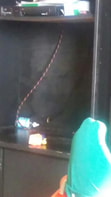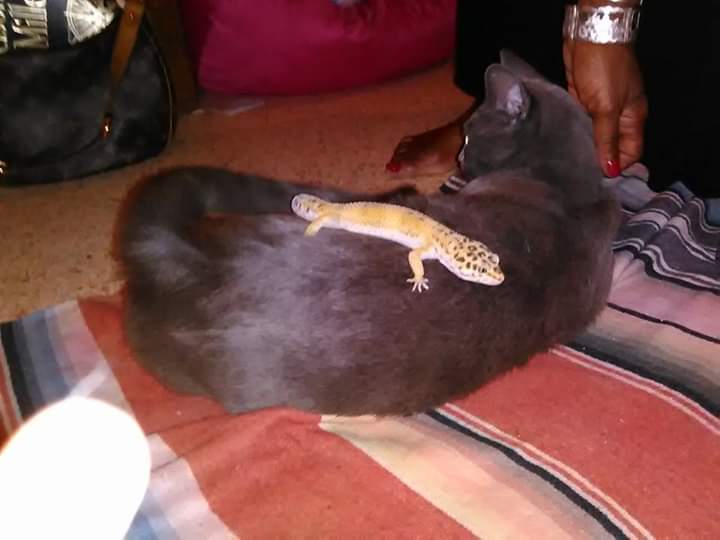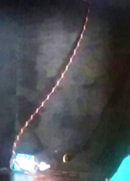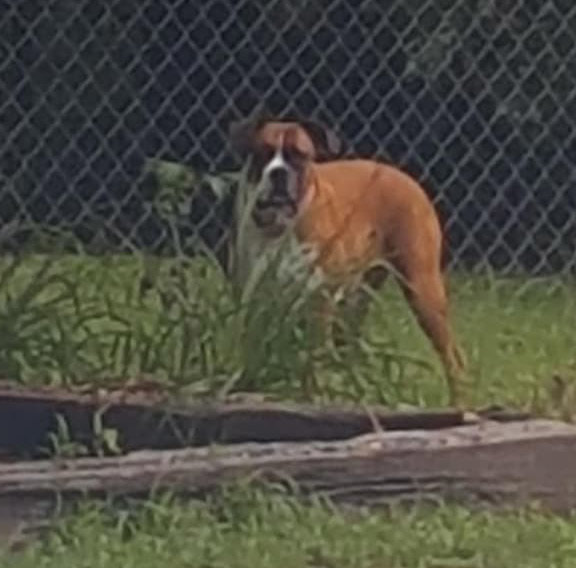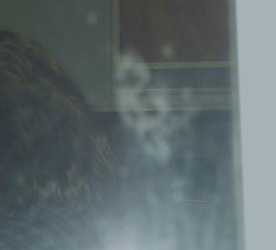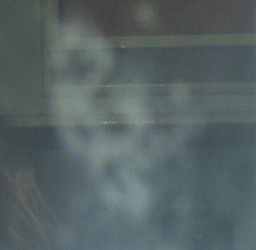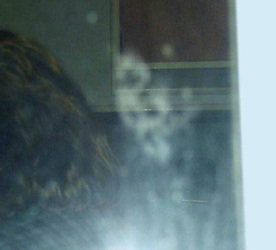Please note: copyright of these photographs belongs to the photographer. They have given permission for the photos to be used on this website only. The images shown here are copyright and may not be downloaded and reproduced elsewhere.
Pareidolia, apophenia
|
The word pareidolia refers to the human tendency to perceive random things occurring in nature as significant, usually meaning of human origin. Examples are seeing a face in the bark of a tree (visual pareidolia, and the human-appearing thing is a simulacrum) or hearing a human voice in the white noise of radio static (audio pareidolia). More recently, Michael Shermer has also used the word patternicity to mean a similar thing. Also see apophenia - the human tendency to find relationships between things or events that have no connection to each other.
The usual story with pareidolia effects in photographs is that nothing unusual was noticed when the photo was taken; the face or human figure was only noticed upon reviewing the photographs, and then the significance is ascribed. Wikipedia article on Pareidolia |
Faces can pop up anywhere
Like in your TV console. This photo understandably had the photographer heading for her church to get holy water with which to treat the area.
We can't be absolutely sure, but the cause of the face appearing here could be due to the way cameras tend to sharpen up and add contrast to shadow areas, where there is not much clear image data to work with. We've been sent photos with figures that look like imps or demons hiding in the shadows, like behind a partially open wardrobe door. Scary stuff, if it's in your house, but probably the result of underexposure of the darker area of the photo, image processing accentuating things, and our brains joining the dots to make us see a semi-human figure or a face. This is pareidolia at work. We see examples of pareidolia very often, mainly in photos of low resolution or in small areas of larger photo files. Along with lens flare, it is responsible for most photo that people think may show something paranormal.
|
Ghost Dog?Maybe pareidolia doesn't just apply to human-like faces and forms. This photo was sent to us in July 2018 from Lotus Grove, Georgia, USA. When taking the photo with her cellphone, Linda only saw her dog and nothing else. Weather conditions were clear.
Paredolia is a possible explanation for the apparent second dog, with grass and shadows combining to for the dog-like entity. Or is it? We're not certain. We wonder if we would see the second, ghost dog if the main subject of the photo was something else. |
Ghost in the kitchen?
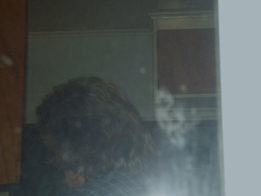
This photo was taken by the woman's daughter in a kitchen. No appliances were on at the time.
The swirly white patterns appear to be close to the camera lens, and are possibly lens flare, exacerbated by a smear of something on the camera lens. At first we thought it was steam, but we were informed that no appliances were turned on in the kitchen, so that explanation seems less likely. Also, it is not a reflection in glass.
However, the flare pattern on the lower centre-right of the photo suggests a flash reflection off something, perhaps a shiny cupboard handle or similar, or even a piece of jewellery on the hand of the photographer, which may then be highlighting a fingerprint or other mark on the camera lens, creating the head-shape.
Because the process of photography compresses three dimensions down to two, it is difficult to get a sense of depth in photos such as this. While the figure looks like it is (in part) standing behind the woman's shoulder, it is more likely smaller and much closer to the camera, on the surface of the camera lens or within it.
Once again, pareidolia (also called matrixing - the tendency we have to see human faces in random shapes) would seem to be the major factor here. But we would have to say this is one of the most uncanny photographs we have yet received. The above could be the explanation of it, but you may disagree.
As with many photographs that suggest paranormal activity, the photo should not be considered in isolation but rather as a single piece in a larger puzzle. Photos and other pieces of possible evidence should be looked at within the context of any investigation of the site and events. We are not writing this photograph off, in other words.
The swirly white patterns appear to be close to the camera lens, and are possibly lens flare, exacerbated by a smear of something on the camera lens. At first we thought it was steam, but we were informed that no appliances were turned on in the kitchen, so that explanation seems less likely. Also, it is not a reflection in glass.
However, the flare pattern on the lower centre-right of the photo suggests a flash reflection off something, perhaps a shiny cupboard handle or similar, or even a piece of jewellery on the hand of the photographer, which may then be highlighting a fingerprint or other mark on the camera lens, creating the head-shape.
Because the process of photography compresses three dimensions down to two, it is difficult to get a sense of depth in photos such as this. While the figure looks like it is (in part) standing behind the woman's shoulder, it is more likely smaller and much closer to the camera, on the surface of the camera lens or within it.
Once again, pareidolia (also called matrixing - the tendency we have to see human faces in random shapes) would seem to be the major factor here. But we would have to say this is one of the most uncanny photographs we have yet received. The above could be the explanation of it, but you may disagree.
As with many photographs that suggest paranormal activity, the photo should not be considered in isolation but rather as a single piece in a larger puzzle. Photos and other pieces of possible evidence should be looked at within the context of any investigation of the site and events. We are not writing this photograph off, in other words.
The face in the middle
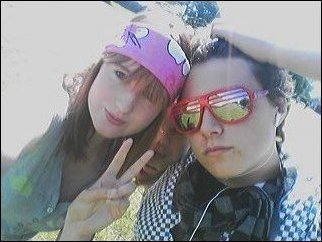
The original photo (right) is from a cellphone camera, so the resolution is low and the image is compressed (322x242 pixels, 22KB). It was taken by the girl, holding the camera out at arm's length, and includes her and her friend. There was no one else in the photograph and we have no cause to believe the photo was faked. Also, there was no reported feeling that anything was unusual at the time the photo was taken; the anomaly was discovered later.
It seems there is some object, be it the girl's hair combined with the ends of her headscarf, or or some other thing, which has the appearance of a human face - a third person who wasn't there.
It seems there is some object, be it the girl's hair combined with the ends of her headscarf, or or some other thing, which has the appearance of a human face - a third person who wasn't there.
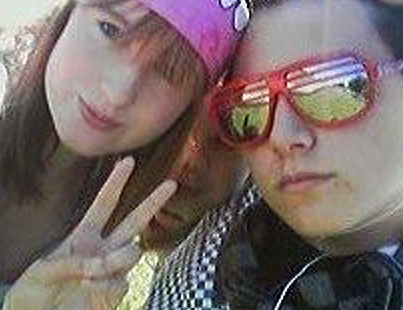
200% enlargement of original, showing artifacts from added pixels
This is probably an example of pareidolia, the tendency of the human brain to find order in random patterns, which can mean seeing faces in objects or hearing voices in random noise, for example. This is sometimes called matrixing.
The poor image quality of the cellphone camera exacerbates the effect described above. If the photo had been taken on a high
resolution, dedicated digital camera, we might not be discussing it.
Our guess is that it's the back of the headscarf that forms the main part of the face, with the ends of the girl's hair coming across at the bottom to form what looks like the mouth and small bearded chin. There is daylight between the girl's fingers and the point of the chin. Also, and more important, is the small amount of daylight showing between the girl and boy's foreheads. This is right where you would expect the top of the head of the anomalous presence to be, blocking out that daylight.
The poor image quality of the cellphone camera exacerbates the effect described above. If the photo had been taken on a high
resolution, dedicated digital camera, we might not be discussing it.
Our guess is that it's the back of the headscarf that forms the main part of the face, with the ends of the girl's hair coming across at the bottom to form what looks like the mouth and small bearded chin. There is daylight between the girl's fingers and the point of the chin. Also, and more important, is the small amount of daylight showing between the girl and boy's foreheads. This is right where you would expect the top of the head of the anomalous presence to be, blocking out that daylight.
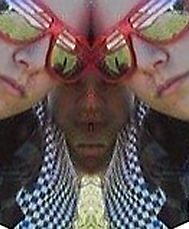
Experiment; cropped and flipped
Anyway, this is only our opinion. As an example of a simulacrum, it is extremely convincing, to the point where we can't altogether write it off. We would like to hear your thoughts on it.
This is one of the most unusual photographs we have received. With the owner's permission, we sent it to the Christchurch Press, where it was published in the article "Ghostly Photos Spark Debate".
This is one of the most unusual photographs we have received. With the owner's permission, we sent it to the Christchurch Press, where it was published in the article "Ghostly Photos Spark Debate".

